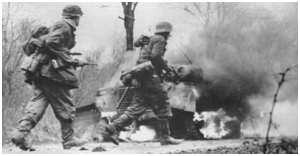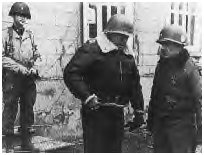Battle
of the Bulge
This is a recap of the Battle of the
Bulge, Joe's first major war experience.
Toward the end of 1944, Hitler knew the war swinging in favor of the Allied Armies and demanded his generals devise a plan to slow the Allied advance. On the morning of December 16, their offensive was launched. Three German Armies, totaling 25 divisions (11 armored) struck six unsuspecting American divisions at Ardennes and overran their lines. Heroic resistance by survivors, the retention of two critical road junctions, and swift reinforcement by both American and British troops halted the German advance.
The two critical road
junctions were at Saint Vith and Bastonge.
St. Vith
On December 17, the American 7th Armored divisions engaged the German
Sixth Panzer Division at Saint Vith and halted their advance. This caused
the Germans to take a slower path and alter their plans. On the same day,
140 Americans were taken prisoner at Bauqnez and were shot by the Germans
while on the road headed for Malmeddy. Some Americans managed to survive
to tell the story. News of the massacre spread quickly through the American
divisions and strengthened their resolve.
Bastonge
Both the Germans and the American 101st Airborne raced to occupy the strategically
positioned city of Bastonge. The Americans arrived first but the Germans
quickly surrounded and laid siege to the city. On December 22nd the Germans
delivered a message to Brigadier General McAuliffe demanding his surrender
of Bastonge. McAuliffe's official reply was "Aw, nuts." This message was
delivered to the Germans by Joseph Harper who relayed its meaning as,
"you can all go to hell." The siege continued.
Because Bastonge was surrounded, the only way to get in supplies was through air drops. But the weather was extremely bad for a long time and planes were not able to fly until the weather cleared. The 101st was finally relieved when the VII Corps moved in and allowed Patton's Third Army to counterattack the Germans. The Third Army then drove the Germans past the border of Bastonge.
American Counteroffensive
Two days before the New Year, a counteroffensive was launched against
the Germans. Patton's Third Army struck the north
while the First Army pushed to the south. The two armies were to meet
at the village of Houffalize to trap the Germans. Progress was painfully
slow and costly because the retreating Germans laid in wait with strategically
located resistance as the Americans wallowed through open fields in deep
snow and frozen ground that provided no shelter.
Hitler's "Great
Blow"
Hitler then launched a plan called the "Great Blow" on January 1st. His
goal was to eliminate Allied air power. German fighter planes swarmed
over Belgium, Holland, and northern France bombarding airfields. Many
Allied aircraft and bases were laid to ruin from the attack but the price
paid by the Germans was devastating. The German Luftwaffe lost 300 planes
and 253 trained pilots.
On January 8th, Hitler realized his offensive had failed and ordered his troops to withdraw. By January 16th, the Third and First American Armies joined at their objective village of Houffalize. This meant that the Allies now controlled the original front. On January 23rd, Saint Vith was retaken and by January 28th the Battle of the Bulge was officially over.
Fighting continued, but Hitler's last ditch attempt to turn the tide in Germany's favor had failed. The Battle of the Bulge was costly to both sides, with both the Americans and Germans each suffering approximately 100,000 casualties with nineteen thousand Americans killed. The remaining German Army was left crippled, a few months away from their final defeat.

German troops in Bastonge
Patton meets McAuliffe in Bastonge

